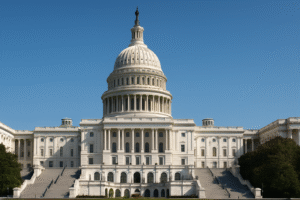Duration & Credit Pulse
Week Ending March 30, 2025
Executive Summary
Bottom Line: Fixed income markets navigated choppy waters as tariff uncertainty collided with mixed economic signals, leaving Treasury yields range-bound while credit spreads began their journey wider from historically tight levels. The 10-year yield held at 4.27% despite intraweek volatility exceeding 20 basis points, as traders balanced flight-to-quality flows against inflation fears from looming April tariff announcements. With consumer confidence plummeting to multi-year lows and manufacturing slipping into contraction, markets positioned defensively ahead of what would become April’s dramatic selloff—making this week the calm before the credit storm.
Duration Dashboard
| Maturity | March 23, 2025 | March 30, 2025 | Weekly Δ | 5-Year Percentile |
|---|---|---|---|---|
| 2‑Year | 3.91% | 3.89% | -2 bp | 42nd %ile (middle range) |
| 5‑Year | 4.05% | 4.08% | +3 bp | 65th %ile (moderate) |
| 10‑Year | 4.24% | 4.27% | +3 bp | 73rd %ile (elevated) |
| 30‑Year | 4.59% | 4.64% | +5 bp | 79th %ile (elevated) |
Curve Steepens on Tariff Anxiety
3.8%
4.0%
4.2%
4.4%
4.6%
2Y
5Y
10Y
30Y
3.89%
4.08%
4.27%
4.64%
March 23, 2025 March 30, 2025
Curve Analysis: Treasury markets exhibited modest bear steepening during the week, with the 2s30s spread widening from 68 to 75 basis points as long-end yields rose more than short-end rates. The curve dynamics reflected growing inflation concerns overpowering near-term growth fears, with 30-year bonds bearing the brunt of term premium expansion. Despite the relatively small weekly moves, intraday volatility told a more dramatic story—the 10-year traded in a 4.15-4.35% range as markets whipsawed between haven demand and tariff-driven inflation anxiety. The front end’s stability at 3.89% reflected solid Fed expectations for continued patience, while the long end’s drift toward 4.65% signaled building concern about fiscal sustainability and embedded inflation.
Treasury markets spent the week in an uneasy equilibrium, with competing forces of flight-to-quality and inflation fears creating range-bound trading that masked significant intraday volatility. The 10-year yield’s close at 4.27% represented a mere 3 basis point weekly increase, but this calm surface belied violent cross-currents beneath. Early week strength saw yields touch 4.15% as equity market wobbles drove haven flows, only to reverse sharply midweek as traders positioned for potential April tariff announcements. The MOVE index remained elevated throughout, signaling continued uncertainty about the path forward.
90-Day Tariff Pause Creates False Calm: President Trump’s March announcement of a “90-day pause on many tariffs” provided temporary market relief but paradoxically increased anxiety about what comes next. The pause, ostensibly to allow for negotiations, created a ticking clock that focused investor attention on early May as a potential inflection point. Markets interpreted the delay not as resolution but as the calm before the storm, with corporate treasurers accelerating import orders and supply chain adjustments. The pause period became a preparatory phase for the volatility to come, with credit markets beginning their defensive rotation even as Treasury yields remained relatively stable.
Credit Pulse
| Metric | March 23, 2025 | March 30, 2025 | Weekly Δ | 5-Year Percentile |
|---|---|---|---|---|
| IG OAS | 91 bp | 94 bp | +3 bp | 19th %ile (very tight) |
| HY OAS | 335 bp | 342 bp | +7 bp | 15th %ile (extremely tight) |
| VIX Index | 16.42 | 18.15 | +1.73 | 52nd %ile (moderate) |
Credit markets showed early signs of stress even as spreads remained near historic tights, with investment grade widening a modest 3 basis points to 94bp while high yield moved 7bp wider to 342bp. Despite the widening, both markets remained firmly in compressed territory—IG at the 19th percentile and HY at just the 15th percentile of their 5-year ranges. This disconnect between still-tight spreads and rising volatility (VIX up to 18.15) created a dangerous dynamic where risk was being repriced slowly even as fundamental concerns mounted. The pace of new issuance had already begun to slow, with March supply running 15% below the torrid Q1 pace as treasurers sensed changing winds.
Historic Spread Compression Meets Tariff Reality: With high yield spreads at the 15th percentile despite looming trade wars, credit markets exhibit extreme vulnerability to repricing shocks. The 342bp level last seen consistently in 2007 offers virtually no cushion for the earnings compression that tariffs will inevitably bring. Investment grade’s 94bp spread similarly prices perfection into a decidedly imperfect world. The cognitive dissonance is stark: spreads imply goldilocks economic conditions while consumer confidence crashes and manufacturing contracts. April’s violent widening would prove these March levels unsustainable, but the warning signs were already flashing for those willing to see them.
US Macroeconomic Assessment – Economy at Crossroads
The week of March 24-30, 2025 delivered a sobering assessment of an economy caught between resilient services activity and deepening manufacturing weakness, all while consumer confidence collapsed on tariff fears. The data painted a picture of an economy at a critical inflection point, with traditional engines of growth sputtering just as policy uncertainty reached new heights.
Consumer confidence crashes to recession levels: Tuesday’s Conference Board Consumer Confidence reading delivered the week’s most alarming signal, plummeting to 92.9 from 100.1 and badly missing consensus expectations of 94.5. The expectations component cratered to just 65.2—a 12-year low and well below the 80 threshold historically associated with recessions. Survey respondents explicitly cited tariff concerns and inflation fears as primary worries, with the percentage expecting higher prices over the next year jumping to the highest level since 2022. Only households earning above $125,000 maintained any semblance of optimism, highlighting growing economic stratification.
Manufacturing-services divergence widens dangerously: Monday’s S&P Global Flash PMI data crystallized the economy’s split personality. While the services PMI improved to a healthy 54.3, manufacturing slipped into contraction at 49.8 versus expectations of 51.9—the first sub-50 reading since the 2023 regional banking crisis. New orders collapsed and inventories built, suggesting further weakness ahead. The composite PMI of 53.5 masked this dramatic divergence, but sector-level data revealed manufacturing’s accelerating deterioration as tariff uncertainty froze capital spending decisions.
Durable goods surge masks underlying weakness: Friday’s durable goods report epitomized the challenge of parsing economic data in uncertain times. The headline 9.2% monthly surge vastly exceeded the 2.1% consensus, but this was entirely driven by volatile aircraft orders jumping 27%. Core capital goods orders—the true measure of business investment—barely budged at 0.1%, revealing corporate America’s defensive crouch. Even more concerning, shipments lagged orders significantly, suggesting companies were hoarding inventory ahead of potential supply chain disruptions. This pre-emptive behavior would prove prescient given April’s tariff implementation.
Federal Reserve Policy Outlook
The Federal Reserve maintained its increasingly precarious balancing act during the week, with no major communications but important technical adjustments that revealed growing concerns about market functioning. The central bank’s challenge has evolved from simple inflation-fighting to navigating a complex landscape where trade policy threatens both growth and price stability simultaneously—a combination that renders traditional monetary tools largely ineffective.
The week’s most significant Fed development came via the quiet announcement that quantitative tightening would slow dramatically beginning in April, with Treasury redemptions falling from $25 billion monthly to just $5 billion while MBS runoff continues at $35 billion. This technical adjustment, buried in the H.4.1 balance sheet report showing total assets at $6.7 trillion, reflected growing concerns about reserve scarcity and repo market functioning. With reserves still ample at nearly $3.5 trillion, the slowdown appeared precautionary—but it also conveniently provided support for Treasury markets just as foreign demand questions intensified. Market pricing remained steady with two rate cuts still expected in 2025, though conviction weakened considerably as traders grappled with the stagflationary implications of sustained tariffs.
Week Ahead: Critical Data Before April Storm
- ISM Manufacturing (April 1): March ISM manufacturing takes on heightened importance as final read before tariff implementation. Consensus expects continued weakness at 49.5, but forward-looking components like new orders and prices paid will reveal how severely tariff fears impacted activity.
- JOLTS Job Openings (April 2): February JOLTS data provides labor market temperature check. Openings expected to moderate to 7.6 million from 7.8 million, but quit rate more important as indicator of worker confidence amid uncertainty.
- ISM Services (April 3): Services ISM critical given sector’s relative resilience. Consensus sees slight cooling to 53.0 from 54.5, but any sub-52 reading would signal concerning broad-based deceleration.
- March Employment Report (April 4): Good Friday jobs report caps crucial week. Consensus expects 175K jobs with unemployment steady at 4.2%, but market focus on wage growth given inflation concerns.
- FOMC Minutes (April 3): March 18-19 meeting minutes provide insight into Fed thinking on tariff impacts. Look for discussion of stagflation risks and any dissent on maintaining patience.
US Economic Positioning and Global Context
As March drew to a close, the United States economy stood at a precarious juncture where domestic resilience met global fragmentation head-on. The remarkable divergence between still-solid services activity and contracting manufacturing created an unstable equilibrium vulnerable to policy shocks. With the 90-day tariff pause entering its final month, markets began the difficult process of pricing in a new reality where decades of globalization would unwind in quarters, not years.
Dollar paradox deepens: Perhaps no dynamic better captured market confusion than the dollar’s 7% decline since tariff tensions began—exactly opposite traditional “risk-off” patterns. This counterintuitive weakness reflected growing international concern about U.S. policy predictability and fiscal sustainability, with the trade deficit’s surge to $131.4 billion in January exposing the irony of protectionist policies worsening the very imbalances they aimed to fix. Foreign central banks’ increasingly urgent discussions about payment system alternatives and reserve diversification gained momentum, though actual changes remained modest. For fixed income investors, this dollar uncertainty added another layer of complexity to an already challenging environment. The week ending March 30 would prove to be the last gasp of relative calm before April’s violent repricing, validating defensive positioning by prescient investors who recognized that historic spread tights and elevated Treasury yields created an asymmetric risk profile decidedly skewed to the downside.
Key Articles of the Week
- US S&P Global Manufacturing PMI drops to 49.8 in March, Services PMI improves to 54.3
FXStreet
March 24, 2025
Read Article - Markets News: Stocks Surge as Investors React to Latest News on Tariffs; Tesla Jumps 12%
Investopedia
March 24, 2025
Read Article - US Consumer Confidence tumbled again in March
The Conference Board
March 25, 2025
Read Article - Consumer confidence plummets to lowest level since January 2021
CNN Business
March 25, 2025
Read Article - BOJ discussed chance of more rate hikes at January meeting, minutes show
Reuters
March 25, 2025
Read Article - Consumer confidence drops to four-year low
Specialty Fabrics Review
March 27, 2025
Read Article - Gross Domestic Product, 4th Quarter and Year 2024 (Third Estimate)
U.S. Bureau of Economic Analysis
March 28, 2025
Read Article






